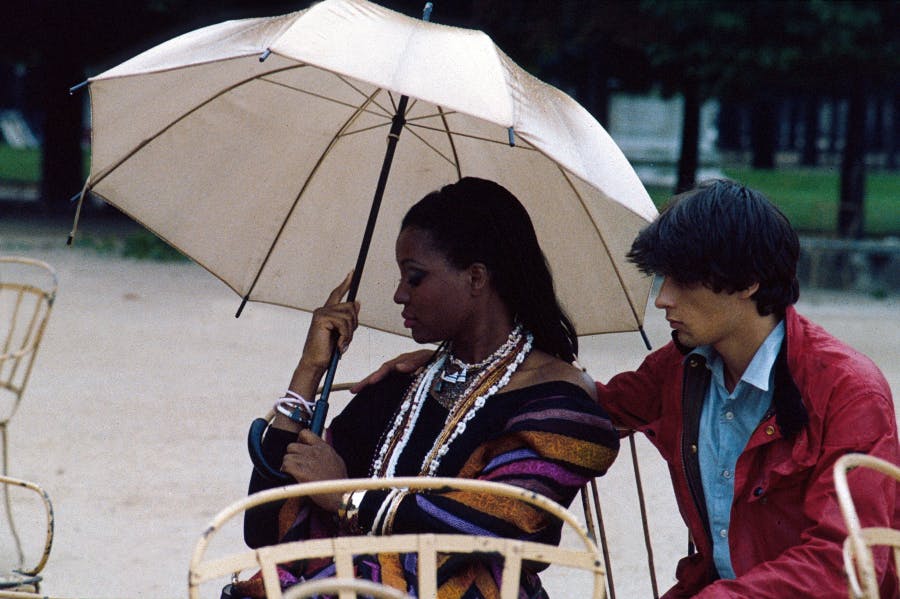The Beauty of This ‘Diva’ Has Not Faded in 40 Years
The film is widely considered to be an early and key example of “cinema du look,” an undeclared movement that emphasized reckless youth, high and low culture, and vibrant, eye-popping imagery.

The first appearance of the Arc de Triomphe in the French film “Diva” is not the typical long shot down the Champs-Élysées. Instead, we see the inner rim of its arch, with the camera starting at the top of the classical curve and then panning down to its base, where two characters stroll beneath in silhouette. Enchanting and unexpected, the shot epitomizes everything that’s wonderful about the 1982 movie being re-released at the Film Forum this weekend.
The first film by director Jean-Jacques Beineix, who died in January, “Diva” is widely considered to be an early and key example of “cinema du look,” an undeclared movement that emphasized reckless youth, high and low culture, and vibrant, eye-popping imagery.
The film is very much an artist’s dream, with its shots of obscure Parisian neighborhoods and spacious apartments outfitted with fantastic paintings, photography, objets d’art, and a general air of bohemia. At one point, the lead character’s apartment is broken into and when Jules returns home it could be said that his place is even more art-directed than before the break-in, with tossed-about chairs and record jackets and hanging strings of audio tape looking very much like a contemporary art installation.
There’s also a chase scene during which the camera follows a motorcycle as it twirls around Parisian roundabouts, then down subway stairs and escalators, then up, until finally the driver ditches the bike to make a run for it. The metro stations involved in this action set piece are of course well-chosen, each one bursting with colorful walls and angular perspectives. This sequence is rightfully remembered as masterful, with Roger Ebert in his 1982 Chicago Sun-Times review comparing it to scenes in “The French Connection,” “Bullitt,” and other classics.
Ostensibly a thriller, the movie goes through some genre motions, with the main plot concerning the murder of a prostitute, drugs, and the hero’s unlucky involvement in it all. Real menace and violence does creep in now and then, but the main thrill of “Diva” is the way it looks and the way it’s filmed by Philippe Rousselot, the Academy Award-winning cinematographer. Through beautiful static shots, elegant camera movements, kinetic street filming, and more, M. Rousselot transforms what could have been a run-of-the-mill, albeit tersely French, thriller into a celebration of color, form, and verve.
Director Beineix does attempt to give the murder mystery a wider perspective by tying a prostitute’s audio confession of a wide conspiracy to the unauthorized taping of a never-recorded opera singer’s recital. Perhaps he wanted to make a point about how women are often at the mercy of unscrupulous men, even when they’re telling — or singing — the truth. Yet this element can come off a bit pretentious and even contradictory, especially in a movie that revels in beauty, light-hearted eroticism, and off-beat humor.
As was the case in the 1980s, the romance between lithe lead actor Frédéric Andréi and real-life opera singer Wilhelmenia Wiggins Fernandez never quite gels, or convinces. Would this gorgeous, majestic “diva” really fall for a just barely post-pubescent postman? More engaging is Jules’s budding friendship/potential relationship with Alba, played by the charming Thuy An Luu. Alba seems to be in a relationship with artist/existentialist/cook/car connoisseur/doctor/enigma Gorodish (Richard Bohringer), though the viewer is left to guess at the nature of their cohabitation.
Much goes unexplained, but just as much will be remembered: like the opening scene, when Fernandez passionately sings a little-known Italian aria while wearing an alluring satin dress in a tastefully crumbling opera house. This aria is heard several times during the movie, and this viewer swooned at each instance. Similar to the aria’s effect, Beineix and Rousselot cast an imagistic spell, even if the movie’s meanings and lyrical elements don’t quite add up to a perfect poem.

